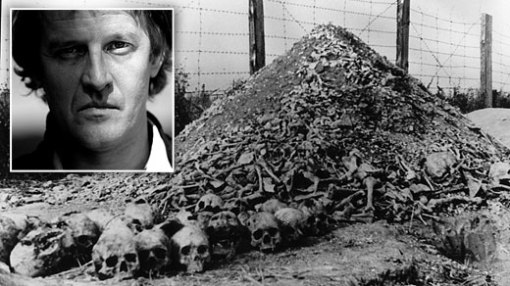
Source: Judy Maltz, Haaretz, April 11, 2013.
The very first interview Claude Lanzmann recorded for his groundbreaking nine-and-a-half hour documentary “Shoah” ended up on the cutting-room floor. It was an interview he conducted almost 40 years ago in Rome with Benjamin Murmelstein, a Viennese rabbi and intellectual who served as the last head of the Jewish Council in Theresienstadt. Although the question-and-answer session went on for an entire week, generating hours upon hours of tape, Lanzmann never found an appropriate place for it.
Until now.
These outtakes from “Shoah” form the basis of Lanzmann’s soon-to-be-released film, “The Last of the Unjust” (a play on the title of Andre Schwarz-Bart’s classic French novel), a three-and-a-half hour documentary that reveals, in his words, “the height of Nazi cruelty and perversity.” Lanzmann promises that the testimony featured in his latest cinematic work is the ultimate rebuttal to the “so-called banality of evil” theory popularized by Hannah Arendt – whom he disparagingly refers to as “Frau Arendt” – by demonstrating just how corrupt and conniving a man was Holocaust mastermind Adolf Eichmann.
In addition to Murmelstein, the film has two other protagonists: Claude Lanzmann of today and Claude Lanzmann of 40 years ago.
“Yes, I am also an actor in this film,” the world-renowned filmmaker tells Haaretz. “You can see me at two very different ages, and one certainly needs courage to do something like this.”
Lanzmann is in Israel this week as a guest of the Jerusalem Cinemateque, where he presented “Shoah,” his 1985 landmark film, as part of a month-long retrospective on his cinematic work, all of which focuses on the Jewish and Israeli experience.
The editing on his latest film, says the 87-year-old, was extremely draining. “For two years, I edited for 10 hours a day,” he says. “I’m blind by now.”
And where does someone his age find that sort of energy? “I have no age, and this is my problem,” says Lanzmann. “I have a very strange relationship with time, because to be able to work 12 years on a film, as I did on ‘Shoah,’ you cannot do it if time is a normal thing in your life. For me, time stops. It does not pass by.”
Lanzmann is pacing around, conducting business in French over the phone, as we enter his suite at the Jerusalem King David Hotel. When he eventually sits down, he makes a point of letting us know he was not at all happy with a certain story that appeared on the front page of Haaretz the previous day. It was a story about European film archives profiting from their collections of Holocaust footage. What angers him is not that anyone would be making money off of images of genocide, but rather, that anyone would dare suggest that any such images exist.
“They don’t,” he says categorically. “The core of the story is the gas chambers, and there is no footage from inside the gas chambers. All other sorts of footage are side things.”
When “Shoah” was broadcast in weekly TV segments in Iran two years ago, Lanzmann took the opportunity to write an open letter to Mahmoud Ahmadinejad, the world’s most notorious Holocaust denier, reassuring the national leader he had nothing to fear.
“I said ‘If you want to find proof in ‘Shoah’ that the Shoah really happened, you will not find this proof. Why? Because there is not one single corpse in ‘Shoah’. And that’s because there were no corpses. People who arrived in Auschwitz were gassed within the first two hours. Their bodies were turned to ashes, and these ashes were dumped in sacks in the river or allowed to blow away in the wind.”
Indeed, “Shoah” was considered revolutionary in its time not only because of its length but because it relied entirely on first-person testimony and did not incorporate any archival footage. As Lanzmann explains his approach to filmmaking:
“The voices of the Sonderkommando [the Jewish prisoners in the death camps forced to dispose of the bodies], the people who got as close as was possible to the actual killing, and the voices of the killers are much stronger than any image.”
Two months ago, when he was awarded the Honorary Golden Bear Award for lifetime achievement at the Berlin International Film Festival, Lanzmann had the opportunity, after quite a long time, to watch “Shoah” again. “It was difficult,” he acknowledges. “It’s a powerful film, even for me.”
Before beginning work on his latest film, Lanzmann had taken a break from filmmaking for a few years to complete his memoir, “The Patagonian Hare,” recently translated into Hebrew. Meanwhile, he continues to serve as chief editor of Les Temps Modernes, a journal founded by Jean-Paul Sartre and Simone de Beauvoir.
Does he prefer one form of storytelling to another? “There’s not much difference between them,” he responds. “To make a film is a way of writing and in the book ‘The Patagonian Hare,’ there are many films, in fact, very beautiful films, but I will not be the one to make them.”
Lanzmann is surprised to hear that so many Jews from his native France have relocated to Tel Aviv in recent years. “Tel Aviv – really?” he asks. “I thought they liked Netanya.” When we discuss whether they are justified to feel threatened by anti-Semitism in France, Lanzmann is skeptical.
“I think it’s exaggerated. One cannot blame the institutions or the government in France – they are very vigilant. One never knows, but I don’t think it will develop in an unbearable way.”
Known around the world as a staunch defender of Israel, Lanzmann hesitates to say anything critical about the country or its leaders.
“I have always cared more about what unites Israelis than what divides them,” he says. “Whether they’re leftists or rightists, no leader has ever said a word about Israel’s nuclear weapon. They know to keep a secret. When they are abroad, they also speak the same language. Even Haaretz does.”
When asked to weigh in on Culture Minister Limor Livnat’s request that Israeli filmmakers exercise more self-censorship, he offers a nuanced distinction.
“Sometime there are people who make films not for Israel but for abroad – they think that people will like these films because they are critical of Israel,” he says. “But there are also those who criticize Israel out of sympathy and compassion – these are the best ones. I think the people we’re talking about – they can be critics of Israel but they do it out of sympathy. “
Lanzmann says he’s extremely impressed by many of the films coming out of Israel in recent years.
“There are very gifted filmmakers in this country,” he says. But no, he hasn’t seen either of the two Israeli documentaries – “The Gatekeepers” and “Five Broken Cameras” – that were candidates for the Oscar this year. Referring to the former heads of the Shin Bet, interviewed in “The Gatekeepers,” he notes half-joking, “I know some of them, and I know how they were and how they talk when they retire. They become ultra-lefties.”
No, he has no plans at the moment for another film, but yes, definitely another book. Is he willing to give a hint about its subject?
“It’s still too fresh, but there are not many subjects worthy of interest,” he says. “You have life or death – that’s all. And they’re connected.”













